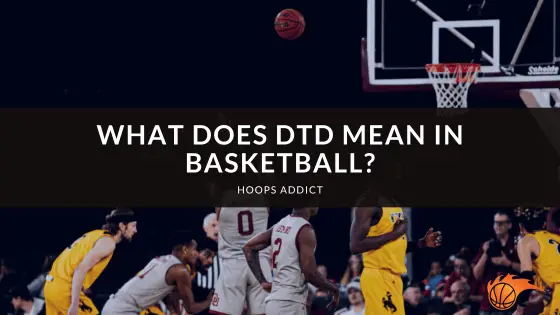The definition of a charge in basketball may need to be clarified for some, especially for rookie players and newbie basketball fans. Often, a charging foul is mistaken for a blocking foul. While both of them are grounds for offensive fouls in basketball, what exactly is a charge in basketball?
Technically, a charging foul happens when an offensive player gets in physical contact with the player taking the defense. Additionally, the defensive player should have both feet on the ground and his torso directed to the offensive.
Read through this blog to know what is the rule on a charge in basketball.
 What Does Charging Mean in Basketball?
What Does Charging Mean in Basketball?
Charging or a charging foul in basketball is a form of an offensive foul. By definition, a charging foul occurs when an offensive player illegally hits or gets in contact with an opponent who is in the proper defensive position.
You will be sanctioned with a charging foul when you run into a defensive opponent with his feet on the ground and his torso facing you. Also, the defensive player should be in place or stationary. In short, a charging foul is only given to an offensive player who gets illegal contact with a player playing the defense.
Also, a charging foul and a blocking foul are different from each other at some point. Although they both are forms of offensive fouls, blocking is committed by a defensive player with the same grounds as the charging foul: the opponent is in the right place and position.
Now, what is the hand signal for charge in basketball? When a player is subjected to a charging foul, the referee will place one hand behind the head and point the opposing direction of the team that is given a charging foul.
Since basketball is a highly competitive sport, some players are strategically positioning themselves to increase the opponent’s tendency to commit a charging foul. Hence, some techniques will help you utilize changing fouls to your advantage while following the basketball rules.
 How to Draw a Charge in Basketball
How to Draw a Charge in Basketball
Block charge call in basketball can be used to your advantage, especially if you know when to pull out this strategic card. Again, the goal is to make the offensive player hit or run into you. Although it puts your safety at risk, drawing a charge will benefit you at the end of the day.
- Plant Both Feet On The Ground, Face The Offensive Player
Again, a charge is not committed when a defensive player is in an illegal position. Therefore, you should always remind yourself to keep both feet on the ground while your body faces the offensive player. Wait for the right time to be stationary and intentionally get hit by the opponent.
- Keep a Defensive Stance (Feet Shoulder-Width Apart and Knees Bent)
This stance is the secret to keeping yourself secure despite the risk of injury when getting run into by the offensive player. If you keep a defensive stance, the fall will not be as impactful as expected. Most of all, try to fall as much as possible to call the referee’s attention.
The video below is a perfect example of a basketball stance. As you can see, the defensive player keeps his body closer to the ground by bending down while maintaining a positive distance from the offensive player.
- Keep Your Distance Close and Wait for the Perfect Time
You cannot simply stand there and wait for an offensive player to hit you—that is impossible. So, you must guard the offensive player and wait for him to change his direction to avoid you. Then, keep your position where he will hit you and have a hard time avoiding you this time.
If you check the first clip of this video, the defensive player pur[posely stood in front of the offensive player at the perfect time. The defensive player did not expect it and had no time to change his direction; thus, he was called for a charging foul.
Although this is a strategic move to lead the game, you must always remember that safety comes first. It would be best if you did not put yourself at risk of injury. Hence, know when to draw a charge at the right time and moment, just like the video above.
Moreover, if you keep asserting yourself to be hit by the offensive player, fate may backfire. Instead of drawing a charging foul, you might commit a blocking foul. That is why it is essential to know the correct position to do so.
 Charging vs. Blocking Foul: What’s the Difference?
Charging vs. Blocking Foul: What’s the Difference?
The reason why it is difficult to distinguish the difference between a blocking foul vs. a charge is that both are offensive fouls. Also, they are committed by a player who gets into illegal physical contact with the opponent.
While committing both results in a personal foul, a blocking foul is sanctioned to a defensive player who impedes the offensive player from dribbling the ball or heading to the basket.
Meanwhile, a charging foul is given to an offensive player who runs into a defensive player. Charging foul is given to the offensive player, while blocking is for the defensive player. In short, both of them are committed when you hit the opponent.
For example, Player A dribbles the ball and runs into Player B (who is still in the correct zone). Therefore, Player A is given a charging foul. On the other hand, if Player A is hit by Player B, then Player B is given a blocking foul call.
 What’s the Penalty for Charging a Foul?
What’s the Penalty for Charging a Foul?
Similar to any other fouls, charging comes with a penalty. There are two cases when one commits a charging foul: turnover or personal foul. Read the sections below to know the complete grounds of these two penalties.
- Turnover
When a player commits a charging foul, it results in a turnover. By definition, a turnover means the team who commits the foul will lose possession of the ball. Sometimes, the other team is also given a free throw advantage in addition to a turnover.
- Personal Foul
The bad thing about a personal foul is that it will be counted as an individual player foul and a team foul. Similarly, the other team will possess the ball and sometimes include a free throw advantage.
Most of all, a charging foul is recorded by the basketball officials. The player will be charged out of the game when he commits five or six offenses—it depends on the game rules how many personal fouls are allowed.
If you are playing the defense, increase your opponent’s tendency to make a charging foul. Meanwhile, keep your distance as much as possible to lower your chance of committing a charging foul if you are an offensive player. Hence, there is no advantage to committing a charging foul.
Wrapping Things Up: What is a Charge in Basketball?
Basketball is all about strategy and wise decision-making. Therefore, you should ensure that every move you make does not cause penalties that will put your team at stake. One of the things you can use to your advantage is charging foul. What is a charge in basketball?
A charging foul is committed by an offensive player who gets in physical contact with a defensive player during a game. The defensive player should have both feet on the ground, not moving or stationary, and the body facing toward the offensive player.
Therefore, not meeting the abovementioned grounds will not be a charging foul. Now, what is the difference between a blocking foul vs. a charge? Both are personal offensive fouls. A charging foul is committed by an offensive player, while a defensive player makes a blocking foul.
You can strategically position yourself to increase your opponent’s chances of committing a charging foul. Stay as close as possible to the offensive player and wait for the right moment to position yourself in a spot where the opponent will run into you while you are on your feet and stationary.
Lastly, bear in mind that your safety should always come first. Do it at the right time and the right moment. The more you assert yourself, the higher your chances of getting injured—which will cause more harm than good. Also, the tides may turn, and you will commit a blocking foul instead.
We hope you enjoyed this post! If you did, be sure to check out our other basketball FAQ articles here.

 What Does Charging Mean in Basketball?
What Does Charging Mean in Basketball? How to Draw a Charge in Basketball
How to Draw a Charge in Basketball Charging vs. Blocking Foul: What’s the Difference?
Charging vs. Blocking Foul: What’s the Difference? What’s the Penalty for Charging a Foul?
What’s the Penalty for Charging a Foul?

